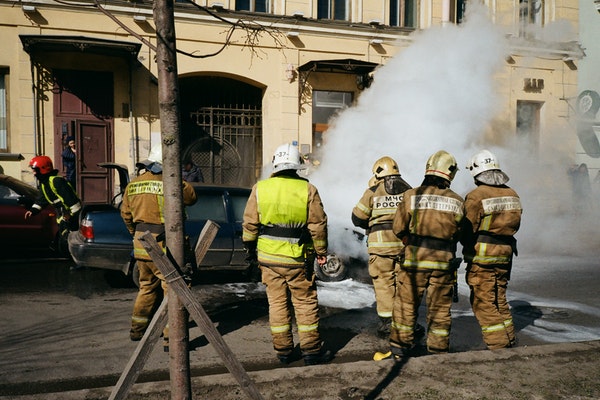
A type of cloth used in fire retardant clothing burns and self-extinguishes. This type of cloth is resistant to burning and aids in reducing heat buildup to prevent the development of quick fire. When fire-retardant clothing is worn in buildings, it makes the air safer. It is a special cloth that prevents fire from spreading. Its materials naturally have fire-retardant qualities and features. A polymer molecule can have the fire-retardant ability chemically inserted into it.
Insights show that a lot of fire incidents are related to clothing burning in the area in question. Cellulosic is used in clothes to increase comfort. But these are dangerous since they are more likely to catch fire. The fabric's weight and kind of weave determine how flammable a piece of clothing is. Generally speaking, clothing with loose weaves burns more whereas heavier, woven clothing burns more slowly.
Treatments to make a Fire-Retardant Clothing
There is a high demand for such clothing since some areas must have fire-resistant qualities. A substance can undergo certain processes to become fire-retardant. Here are a few examples:
1. Thermally resistant fibres
The simplest approach is the use of thermally stable fibres. These fibres are naturally heat-resistant. Even at enormous temperatures, they often continue to have their original molecular structure. Fire does not affect them. Since this stability is an inherent quality, the fibres don't need to be changed because they are always stable. These protective suits made of these fibres are strong and pull.
2. Solid state treatment
By treating non-thermally stable fibres with fire-resistant chemicals, non-thermally stable fibres can be made fire-resistant. This method is frequently used to make natural fibres fire-resistant. Chemicals are used in the design of common clothing. Instead of bonding with the fibres, the chemicals create a layer that extinguishes fire on the fibres, making them fire-resistant.
The ability to withstand fire is instilled into the fibres. Soft, convenient, and lightweight fibres like cotton and rayon have had their composition changed to make them fire retardant.
3. Gas state treatment
The gas-activated fibres contain a layer of chemicals on them that are activated when the fibre comes into contact with fire, similar to solid-state treatments. When exposed to fire, wearables develop a protective layer of gases that resists the fire and prevents the fibre from igniting. The fibre is normal and unreceptive under normal conditions. The gas-treated fibres are less strong and more likely to lose their properties.
Different types of Fire retardant clothing
There are broadly two types of fire retardant clothing. Either the clothing has been chemically treated or it is naturally fire resistant. The process through which the cloth becomes fire retardant is the main difference between these two types. Let's examine the differences in more detail:
1. Inherently Fire Retardant Clothing
The built-in fire retardant of the clothing makes it perfect for usage in your house, workplace, and educational institution, especially for items like curtains and drapes. These clothes are made from fibres that have fire-retardant features; washing them has no negative effects on their features or weakens them. The most fire-resistant natural fibre is thought to be wool, whereas silk is difficult to ignite and burns slowly. Clothing made of synthetic fibres like nylon, polyester, and acrylic is created with built-in fire resistance.
2. Chemically treated Fire Retardant Clothing
These clothes have a chemical covering that resists fire. According to the International Association of Certified Home Inspectors, there are currently more than 175 kinds of fire retardants. These substances are often divided into the following groups:
- Inorganic fire retardants
- Phosphorus-containing chemicals
- Nitrogen-containing chemicals
- Brominated chemicals
- Chlorinated chemicals
Depending on your desired use, you should decide whether to buy treated fabric. For instance, the chemical begins to deteriorate as it is used and washed, and the fabric loses its essential qualities. On the other hand, clothing that is already fire retardant doesn't have this problem. Additionally, keep in mind that applying a fire retardant treatment to a fabric can violate the guarantee provided by the manufacturer.
Applications of fire retardant clothing
Fire retardant clothing is frequently used in tent and parachute fabric, as well as in the clothes of firemen and commercial employees. These clothes can withstand extreme temperatures in a field where a fire might result in accidents. The user of fire-retardant clothing is protected from burns caused by fire, electrical shocks, etc. Most interior items, including blinds, businesses, homes, and schools, use it. The most important feature is that by stopping flames from the beginning and spreading, these clothes safeguard infrastructure while also saving lives.
Conclusion
For places including schools, workplaces, and homes, wearing fire-retardant clothes is a safer choice. These kinds of attire are also needed for a variety of occupations. Finding the proper manufacturer is crucial for your fire retardant project, especially if chemically treated fire retardant apparel is involved. Customers may choose from a wide range of UNITO items that are not only the greatest but also durable and reasonably priced.
Visit Unito for more information
Follow us on:
Facebook | Instagram | LinkedIn | Twitter | Google My Business


